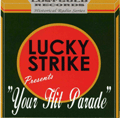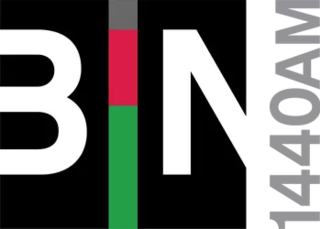Related Research Articles

Nightline is ABC News' late-night television news program broadcast on ABC in the United States with a franchised formula to other networks and stations elsewhere in the world. Created by Roone Arledge, the program featured Ted Koppel as its main anchor from March 1980 until his retirement in November 2005. Its ongoing rotating anchors are Byron Pitts and Juju Chang. Nightline airs weeknights from 12:37 to 1:07 a.m., Eastern Time, after Jimmy Kimmel Live!, which had served as the program's lead-out from 2003 to 2012.

Your Hit Parade was an American radio and television music program that was broadcast from 1935 to 1953 on radio, and seen from 1950 to 1959 on television. It was sponsored by American Tobacco's Lucky Strike cigarettes. During its 24-year run, the show had 19 orchestra leaders and 52 singers or groups.

Arthur Godfrey's Talent Scouts was an American radio and television variety show which ran on CBS from 1946 until 1958. Sponsored by Lipton Tea, it starred Arthur Godfrey, who was also hosting Arthur Godfrey and His Friends at the same time.
The "Friday night death slot" or "Friday evening death slot" is a perceived graveyard slot in American television. It implies that a television program in the United States scheduled on Friday evenings is likely to be canceled.
The NBC Monday Movie was a television anthology series of films that debuted on February 4, 1963. It was referred to as Monday Night at the Movies prior to the mid-1980s. Contrary to popular contemporary belief, the corporate initials, "NBC", were, at first, not part of the official title for the network's anthologies of old movies, and would not be for years to come. Thus, in 1964, when the show was transferred by the network's programming executives to Wednesday nights, it became Wednesday Night at the Movies. And in 1965, when the program moved to Tuesdays, it became Tuesday Night at the Movies. It would remain there until 1969. The name would henceforth change depending on whichever night of the week the program aired. Moreover, by 1968, there was once again a weekly Monday Night at the Movies on the air. It ran until 1997.
WABC is a commercial radio station licensed to New York City, carrying a conservative talk radio format known as "Talkradio 77". Owned by John Catsimatidis' Red Apple Media, the station's studios are located in Red Apple Media headquarters on Third Avenue in Midtown Manhattan and its transmitter is in Lodi, New Jersey. Its 50,000-watt non-directional clear channel signal can be heard at night throughout much of the Eastern United States and Eastern Canada. It is the primary entry point for the Emergency Alert System in the New York metropolitan area and New Jersey. WABC simulcasts on WLIR-FM in Hampton Bays, New York, on eastern Long Island.
Inside the NFL is an American weekly television sports show that focuses on the National Football League (NFL).
The following is the 1958–59 network television schedule for the four major English language commercial broadcast networks in the United States. The schedule covers primetime hours from September 1958 through March 1959. The schedule is followed by a list per network of returning series, new series, and series cancelled after the 1957–58 season.

Who Do You Trust? is an American television game show.
The following is the 1957–58 network television schedule for the four major English language commercial broadcast networks in the United States. The schedule covers primetime hours from September 1957 through March 1958. The schedule is followed by a list per network of returning series, new series, and series cancelled after the 1956–57 season.
College Football on CBS Sports is the blanket title used for broadcasts of college football games that are produced by CBS Sports, for CBS and CBS Sports Network.
The following is the 1950–51 network television schedule for the four major English language commercial broadcast networks in the United States. The schedule covers primetime hours from September 1950 through March 1951. The schedule is followed by a list per network of returning series, new series, and series cancelled after the 1949–50 season. This season became the first in which primetime was entirely covered by the networks. It was also the inaugural season of the Nielsen rating system. Late in the season, the coast-to-coast link was in service.
The following is the 1951–52 network television schedule for the four major English language commercial broadcast networks in the United States. The schedule covers primetime hours from September 1951 through March 1952. The schedule is followed by a list per network of returning series, new series, and series cancelled after the 1950–51 season. This was the first television season of national network interconnection by coaxial cable and microwave, meaning programming could be transmitted live coast-to-coast if needed.
The 1948–49 network television schedule for the four major English language commercial broadcast networks in the United States. The schedule covers primetime hours from September 1948 through March 1949. The schedule is followed by a list per network of returning series, new series, and series cancelled after the 1947–48 season. This was the first season in which all four networks then in operation in the United States offered nightly prime time schedules Monday through Friday.
The 1949–50 network television schedule for the four major English language commercial broadcast networks in the United States. The schedule covers primetime hours from September 1949 through March 1950. The schedule is followed by a list per network of returning series, new series, and series cancelled after the 1948–49 season. This was the first season in which all four networks offered at least some prime time programming all seven nights of the week.

Blondie is a radio situation comedy adapted from the long-running Blondie comic strip by Chic Young. It stars Arthur Lake as Dagwood Bumstead and, for the majority of its run, Penny Singleton as Blondie Bumstead. The radio program ran on several networks from 1939 to 1950.
Radio Luxembourg was a multilingual commercial broadcaster in Luxembourg. It is known in most non-English languages as RTL.

WGVL is a radio station licensed to Greenville, South Carolina. It is owned and operated by iHeartMedia, Inc. The station serves as Greenville's Black Information Network affiliate.
References
- 1 2 Brooks, Tim, and Earle Marsh, The Complete Directory to Prime-Time Network and Cable TV Shows, 1946-Present (Sixth Edition), New York: Ballantine Books, 1995, ISBN 0-345-39736-3, p. 106.